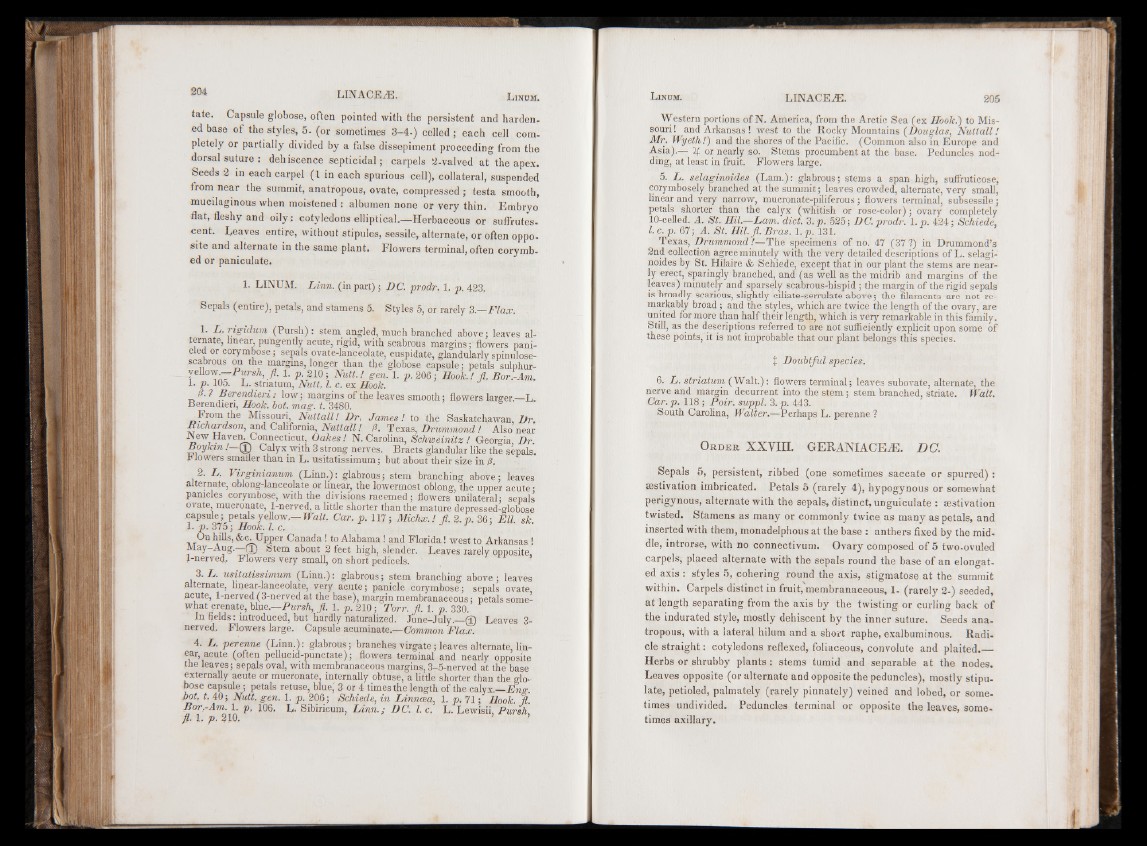
tate. Capsule globose, often pointed with the persistent and harden,
ed base of the styles, 5- (or sometimes 3-4-) celled ; each cell completely
or partially divided by a false dissepiment proceeding from the
dorsal suture : dehiscence septicidal; carpels 2-valved at the apex.
Seeds 2 in each carpel ( l in each spurious cell), collateral, suspended
from near the summit, anatropous, ovate, compressed ; testa smooth,
mucilaginous when moistened ; albumen none or very thin. Embryo
flat, fleshy and oily ; cotyledons elliptical.—Herbaceous or suflrutes-
cent. Leaves entire, without stipules, sessile, alternate, or often opposite
and alternate in the same plant. Flowers terminal, often corymb-
ed or paniculate.
1. LINUM. Linn, (in part) 5 DC. prodr. 1. p. 423.
Sepals (entire), petals, and stamens 5. Styles 5, pr rarely 3.—Flax.
1. L .rig id um (P u r s h ) : stem angled, much branched above; leaves alternate,
linear, pungently acute, rigid, w ith scabrous margins; flowers pani-
cled or corymbose; sepals ovate-lanceolate, cuspidate, glandularly spinulose-
scabrous on the margins, longer th an the globose c apsule ; petals sulphur.
veflow —PwrsA, /Z. 1. p. 210 ; Nutt.! gen. 1. p. 206; Hook.! jl. Bor.-Am,
1. p. 105. L. striatum, Nutt. 1. 0. ex Hook.
P.? Berendieri: low; margins of the leaves smooth; flowers larger.—L.
Berendien, Hook. hot. mag. t. 3480.
From the Missouri, Nuttall! Dr. James! to the Saskatchawan, Dr.
Bichardson, and California, Nuttall! 0. Texas, Drummond ! Also near
iNew Haven, Connecticut, Oakes! N. Carolina, Schioeinitz ! Georgia Dr
Boykin /—m Calyx with 3 strong nerves. Bracts glandular like the sepals,
r lowers smaller than in L. usitatissimum; but about their size in
2. L . Virginianum (Linn.): glabrous; stem branching above; leaves
alternate, oblong-lanceolate or linear, the lowermost oblong, the upper acute;
panicles corymbose, with the divisions racemed; flowers unilateral; sepals
ovate, mucronate, 1-nerved, a little shorter than the mature depressed-globose
capsule; petals yellow.— Walt. Car. p. 117; Michx.! fl. 2. p. 36; E ll sk
1. p. 375; Hook. 1. c. ; .
0n Aids, &c. Upper Canada ! to Alabama ! and Florida! west to Arkansas !
May-Aug. fT) Stem about 2 feet high, slender. Leaves rarely opposite,
1-nerved, Flowers very small, on short pedicels.
3* L. usitatissimum (Linn.): glabrous; stem branching above ; leaves
alternate, linear-lanceolate, very acute; panicle corymbose; sepals ovate
acute, 1-nerved(3-nerved at the base), margin membranaceous; petals somewhat
crenate, blue — Pursh, Jg 1. p. 210; Torr. Jl. 1. p. 330.
In fields: introduced, but hardly naturalized. Ju n e-Ju ly .—® Leaves 3-
nerved. Flowers large. Capsule acuminate.— Common Flax.
4. L. perenne (Linn): glabrous; branches virgate; leaves alternate, linear,
acute (often pellucid-punctate); flowers terminal and nearly opposite
the leaves; sepals oval, with membranaceous margins, 3- 5-nerved at the base
externally acute or mucronate, internally obtuse, a little shorter than the globose
capsule ; petals retuse, blue,' 3 or 4 times the length of the calyx.—Fla«-.
bot, t. 40; Nutt. gen. 1. p. 206; Schiede, in Linncea, 1. p. 71; Hook. fl.
Bor-Am. 1. p, 106. L. Sibiricum, Lin n .; DC. 1. c, L. Lewisii, Pursh,
fl. 1, p . 210, ’
Western portions of N. America, from the Arctic Sea (ex Hook.) to Missouri!
and Arkansas! west to the Rocky Mountains {Douglas, Nuttall!
Mr. Wyeth!) and the shores of the Pacific. (Common also in Europe and
A.sia).— 21 or nearly so. Stems procumbent at the base. Peduncles nodding,
at least in fruit. Flowers large.
5. L. selaginoides (Lam): glabrous; stems a span high, suflruticose,
corymbosely branched at the summit; leaves crowded, alternate, very small,
linear and very narrow, mucronate-piliferous; flowers terminal, subsessile;
petals shorter than the calyx (whitish or rose-color); ovary completely
10-celled. A. St. Hil.—Lam. diet. 3. p. 525; DC. prodr. 1. p. 424; Schiede,
l. c. p. 67; A. St. Hil. fl. Bras. l.p . 131.
Texas, Drummond !—The specimens of no. 47 (37?) in Drummond’s
2nd collection agree minutely with the very detailed descriptions of L. selaginoides
by St. Hilaire & Schiede, except that in our plant the stems are nearly
erect, sparingly branched, and (as well as the midrib and margins of the
leaves) minutely and sparsely scabrous-hispid; the margin of the rigid sepals
is broadly scarious, slightly ciliate-serrulate above; the filaments are not remarkably
broad; and the styles, which are twice the length of the ovary, are
united for more than half their length, which is very remarkable in this family.
Still, as the descriptions referred to are not sufficiently explicit upon some of
these points, it is not improbable that our plant belongs this species.
J Doubtful species.
6. L. striatum (W a lt): flowers terminal; leaves subovate, alternate, the
nerve and margin decurrent into the stem; stem branched, striate. Walt.
Car.p. 118 ; Pair, suppl. 3. p. 443.
South Carolina, Halier.—Perhaps L. perenne ?
Or d e r XXVIII. GERANIACEiE. DC.
Sepals 5, persistent, ribbed (one sometimes saccate or spurred) :
aestivation imbricated. Petals 5 (rarely 4), hypogynous or somewhat
perigynous, alternate with the sepals, distinct, unguiculate : aestivation
twisted. Stamens as many or commonly twice as many as petals, and
inserted with them, monadelphous at the base : anthers fixed by the middle,
introrse, with no connectivum. Ovary composed o f 5 two-ovuled
carpels, placed alternate with the sepals round the base o f an elongated
axis : styles 5, cohering round the axis, stigmatose at the summit
within. Carpels distinct in fruit, membranaceous, 1- (rarely 2 -) seeded,
at length separating from the axis by the twisting or curling back o f
the indurated style, mostly dehiscent by the inner suture. Seeds anatropous,
with a lateral hilum and a short raphe, exalbuminous. Radicle
straight: cotyledons reflexed, foliaceous, convolute and plaited.__
Herbs or shrubby plants : stems tumid and separable at the nodes.
Leaves opposite (or alternate and opposite the peduncles), mostly stipulate,
petioled, palmately (rarely pinnately) veined and lobed, or sometimes
undivided. Peduncles terminal or opposite the leaves, some-
times axillary.